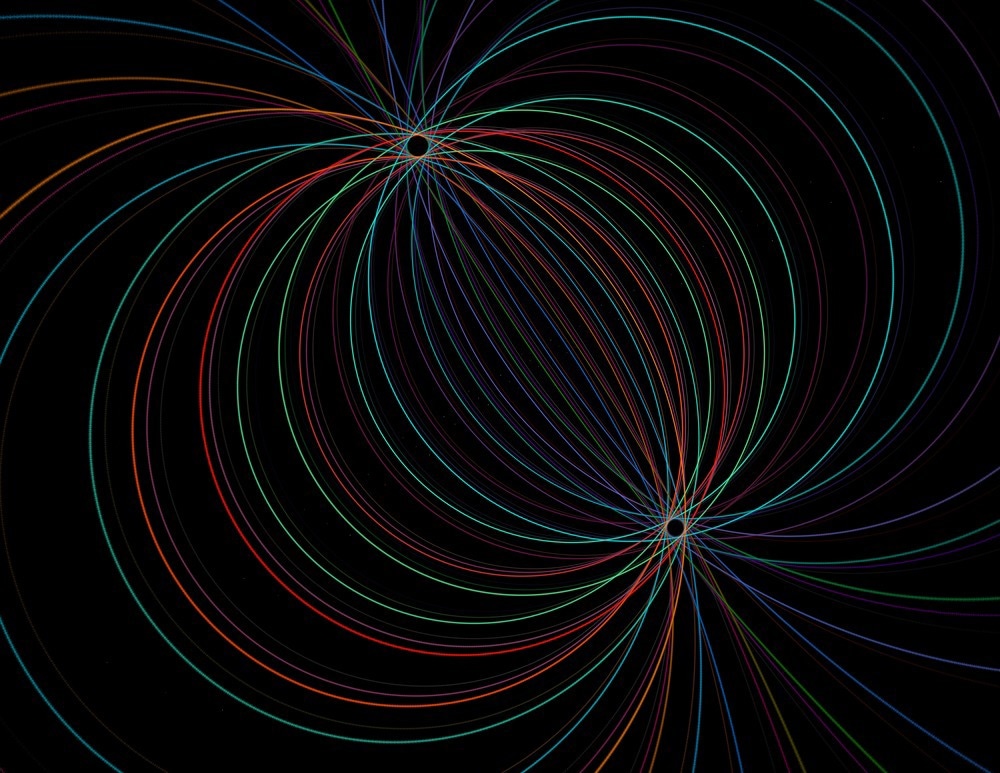According to theoretical physics, nature and the physical world are composed of minuscule vibrating strings that are smaller than atoms, electrons, or quarks. This is known as string theory. This theory states that when the strings vibrate, twist, and fold, they create effects in several minuscule dimensions that people understand to be anything from large-scale phenomena like gravity to particle physics.

Image Credit: Natali art collections/Shutterstock.com
String theory has been proposed as a potential "theory of everything," a unifying framework that would bring together the two main theories of current physics, general relativity and quantum mechanics. While general relativity and quantum mechanics both perform admirably in explaining how very massive things occur in the universe and how extremely small things behave, they don't work well together. Some scientists have held the belief that string theory may answer the paradoxes between the two, solving a significant portion of physics' unresolved mysteries.
However, following its rise to fame in the late 1960s and early 1970s, string theory's acceptance among theoretical physicists wavered, according to a lecture given by physicist John Schwarz of the California Institute of Technology, who is regarded as one of the theory's inventors. Even after innumerable papers, meetings, and dry-erase markers, the amazing discovery that so many had originally hoped for is still finding its footing as an accepted formulation.
Foundations of String Theory
A body of theoretical physics concepts known as string theory holds that strings, rather than particles like the point-like electron, are the fundamental building elements of nature. Analogous to tiny elastic bands that have the ability to stretch and compress. The vibrations of these incredibly tiny strings cause effects that are theorized as atoms, electrons, and quarks.
String theory needs to make one more radical assumption in order for it to function. The postulate requires a universe with nine, ten, or twenty-five dimensions of space, as opposed to one with three dimensions of space and one of time. Like a thread that seems one-dimensional until you get near enough to discover its width, these other dimensions are wrapped up so tightly that the concept is difficult to visualize.
Primarily, string theory is a quantum gravity theory that skillfully integrates the concepts of quantum mechanics with gravity. For almost a century, physicists have been trying to come up with a quantum gravity theory. Furthermore, concepts from string theory have been used in mathematical and other theoretical physics problems.
In many respects, theoretical physicists can utilize string theory as a language to solve issues and explore the mathematics of the cosmos.
Formulation and Evolution of String Theory
The discovery of string theory happened by chance! The now-famous Veneziano amplitude was discovered in 1969 by Italian physicist Gabriele Veneziano, who recorded a formula for the scattering of four strings. Veneziano was not attempting to explain the physics of strings but rather of particles like the proton and neutron. Scientists from all across the world started deciphering string theory from that original formula in the ensuing years.
The string theory of the 1960s and 1970s is not exactly the same as string theory today. Scholars cannot agree on whether it remains the best contender for a "theory of everything" after revisions or if theorists should move on to other subjects.
A few scientists pursued five different iterations of string theory over the course of the following ten years. As time went on, the researchers discovered previously undiscovered relationships among the five concepts.
Over the next fifty years, string theory's whole picture has become more apparent. The 1970s, 1980s, and 1990s saw many breakthroughs and profound discoveries, and string theory is still a thriving field with hundreds of researchers worldwide.
Current Status and Future Outlook
String theory has not been shown to be the underlying theory of nature by any experiment. Nonetheless, during the past fifty years, several theoretical and mathematical studies have proven the viability of string theory concepts.
Basic physics is a long-term endeavor. One hundred years after Einstein's 1915 prediction, gravitational waves were first observed in 2015 by the LIGO experiment! String theory may be definitively tested by cosmological measurements, gravitational wave observatories, or particle physics experiments in the future.
Even if the formulation is never completely proved and the universe does not adhere to the concept of supersymmetry and has many dimensions, the framework of string theory has been successful in connecting whole branches of mathematics.
Specifically, scientists have highlighted links known as dualities, which have turned out to be a significant contribution to both mathematics and physics when they demonstrated that the five-string theories were merely reflections of a single-parent theory.
While some work is being done to apply string theory’s predictive capability, many physicists are turning their attention elsewhere. The true nature of a theory of everything is still obscure, whether it takes the shape of causal dynamical triangulation, loop quantum gravity, or something else entirely is yet to be discovered.
More from AZoQuantum: JWST Finds Methane in Exoplanet Atmosphere
References and Further Reading
Louis, J., et al.: String theory: an overview. Lect. Notes Phys. 721, 289 (2007). 323
Witten, Edward. "String Theory Dynamics In Various Dimensions." Nuclear Physics B 443, no. 1–2 (June 1995): 85–126. https://doi.org/10.1016/0550-3213(95)00158-O.
Wolchover, N (August 9, 2018.). "Dark Energy May Be Incompatible With String Theory." Quanta Magazine, Available Online At: https://www.quantamagazine.org/dark-energy-may-be-incompatible-with-string-theory-20180809/.
Disclaimer: The views expressed here are those of the author expressed in their private capacity and do not necessarily represent the views of AZoM.com Limited T/A AZoNetwork the owner and operator of this website. This disclaimer forms part of the Terms and conditions of use of this website.